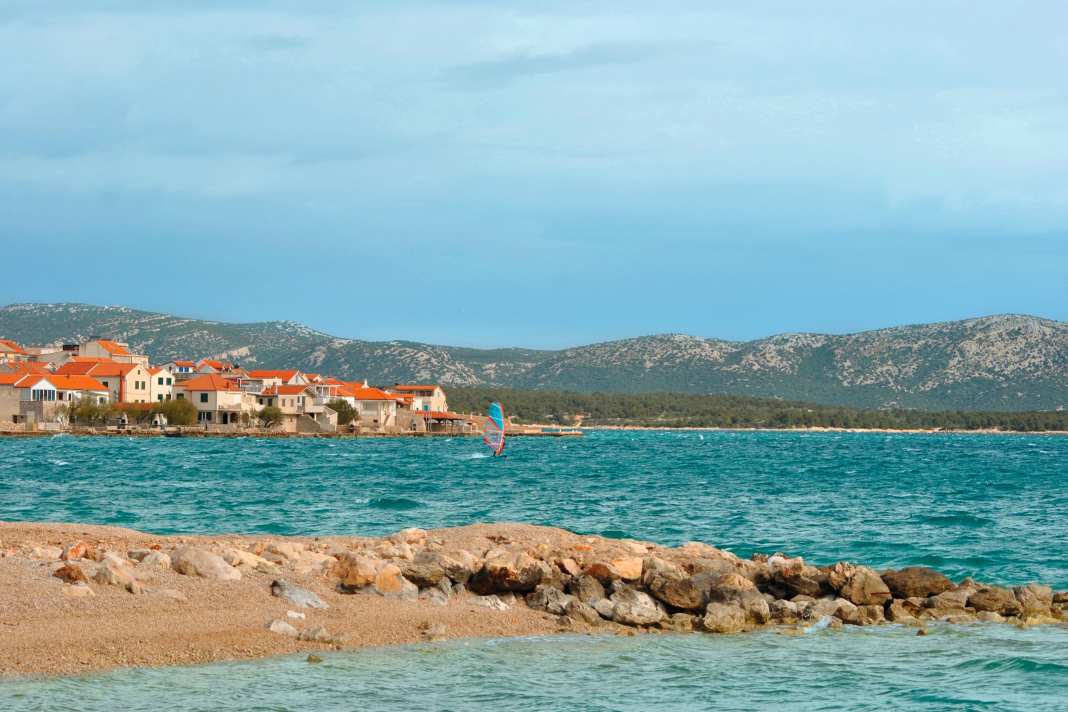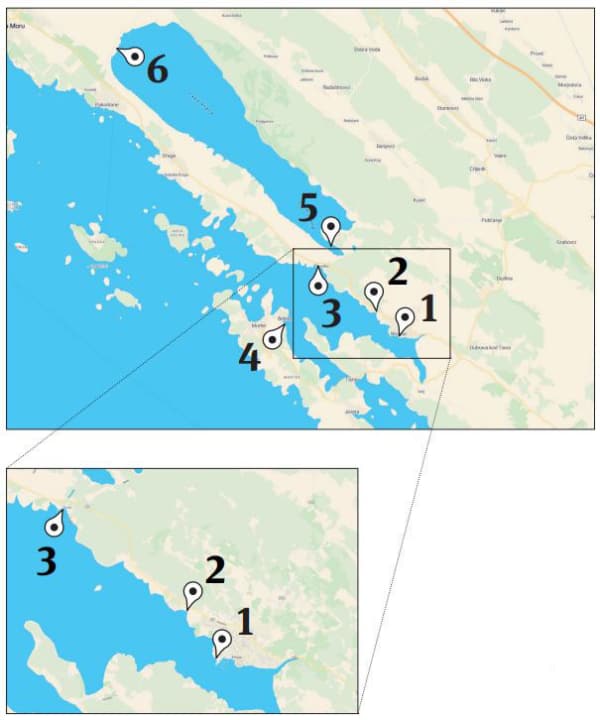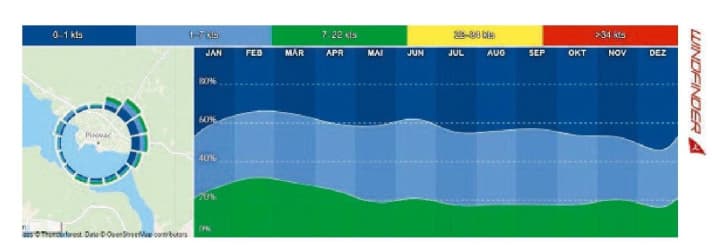Spot Guide Dalmatia: Windsurfing around Pirovac - sometimes sweet, sometimes salty






The total area of Croatia is just under 15 percent of that of Germany, but it has more than 1000 islands with a coastline of more than 6000 kilometres. So there is a lot for us windsurfers to discover. Especially in spring, when nature starts to sprout and life is back in front of the houses.
In this guide, we would like to introduce you to the area around Pirovac and the Murter peninsula in central Dalmatia, between Zadar and Split. We have visited this area several times and have always been impressed by the wind, the beautiful weather and the general tranquillity of the area in autumn and spring.
Easy going in the low season
We spent 16 days in this area again this March - and we had wind on 14 of them: "Jugo" with small sails between 4.0 and 4.8 square metres at a pleasant 22 degrees air temperature, angry "Bora" with five to seven Beaufort and a nice thermal with a pleasant 20 knots and sunshine - it's all here. The windsurfing heart beats faster. We were always alone on the water at this time of year, with only a few sailing boats passing by.
We are always amazed by the wind yield, the beautiful weather and the peace and quiet.
In the winter months, we have found that 40 to 50 per cent gliding wind can be expected in this area. In the summer months, you can expect wind for foil, wing and large sails on at least 30 to 40 per cent of the days due to the prevailing thermals. From Whitsun and in the height of summer, Croatia has been very popular with tourists for several years and it can get really crowded. In the low season, however, it is easy going on land and on the water - there is endless space.
Lake Vrana: a Mediterranean swamp
During our last trip to Croatia in March, we not only surfed on salt water, but also on the largest natural lake in Croatia, not far from the other spots around Pirovac. The Mediterranean swamp is located in a 57-square-kilometre nature park, in which the lake makes up the majority of the total area with an area of 30 square kilometres. With a shoreline length of over 45 kilometres, Lake Vrana is a paradise for anglers, hikers and cyclists and also offers great opportunities for windsurfing. There are nature conservation zones around the lake, which must of course be respected. However, access for windsurfers is possible at two spots identified for the guide. Have fun exploring.
The best windsurfing spots around Pirovac

1st Pirovac Marina
43.817338, 15.661760
The spot is located west of the marina, in a long, narrow bay (distance to the other side of the shore approx. 500 metres), which widens towards the northwest like a funnel. The south-easterly blowing Jugo comes directly sideshore from the left and is reinforced by a furrow. At the beginning the water remains very smooth, in the centre of the bay it becomes choppier, but on the opposite side it becomes much smoother again.
When the wind blows from the south-east, the harbour wall of the marina forms a small wind cover for the first 50 metres. If the Jugo is blowing a little more southerly, the wind comes diagonally onshore and is gusty, as it first has to go over a small hill. The better spot is then Pirovac petrol station, only 700 metres west of here.
The thermal from the west-north-west comes sideshore from the right and usually blows very consistently. However, the harbour wall of the marina then produces quite choppy water. It is therefore better to surf upwind, where the bay widens - there you will find nice flat water for heating and practising. The entrance is easy via a narrow, coarse pebble beach section. Only the first few metres are shallow. There is a car park (subject to a charge) and set-up facilities directly in front of the beach section.

2nd Pirovac petrol station
43.825435,15.654276
Coming from Zadar, before entering Pirovac, about 30 metres before the petrol station, turn right into the access road to the beach. It is then less than a hundred metres to the water. The spot works best with a southerly jugo, up to a maximum of south-southeast, and with thermals from the west-northwest. The southerly jugo blows diagonally onshore from the left and is more constant than at Marina Pirovac, although the spots are only one kilometre apart. Depending on the wind strength, the water surface offers flat water with up to half a metre of clean chop.
On the other hand, the water remains relatively smooth in westerly-north-westerly thermals, and the first 50 metres from the beach are slightly covered. The entrance here is also via a coarse pebbly section of beach. The standing area is just under five metres wide. There are parking and set-up facilities, almost sheltered from the wind by bushes and trees, along the unpaved access road that slopes down to the sea.

3. prosika
43.843197, 15.623835
This spot is located about three kilometres northwest of Pirovac, where the Prosika Canal connects Lake Vrana with the sea. Prosika consists of a few holiday homes, a small hotel and a harbour. From there you have a beautiful view of the opposite side, towards Murter and Betina.
The jugo from the south-east comes sideshore here and is covered by land upwind, which means you first have to bob out about 200 to 300 metres before the gliding fun can begin. Jugo from the south comes diagonally onshore, so it has a free approach and is the better choice at the spot, although the first 100 metres are quite choppy due to the harbour and the bank reinforcement.
Parking is available on the road and by the canal. The entrance is at the end of the canal on a narrow, gravelled headland or from Camp Kalebic to the north. At both entrances, the water is already deep after a few metres.

4th Betina on the Murter peninsula
43.819110, 15.605836
Generally the best spot when the bora is blowing. If the bora comes from a northerly direction, the wind is more sideshore and a small chop is created, which is perfect for heating or freestyling. When the bora is more easterly, the wind comes slightly onshore from the left and the chop is not quite as pleasant.
When the jugo comes from the south-east, the wind blows slightly onshore from the right and, depending on the wind strength, a wind wave is created that can be half a metre high. If the jugo comes from the south, it blows sideshore from the right and the chop remains smaller. The entrance, with a few metres of standing area, is several hundred metres along the pebble beach. There are numerous car parks right by the water. These are free of charge in the low season.

5. lake Vrana South (Prosika)
43.849856, 15.630101
Lake Vrana, one of the last Mediterranean marshes, is reminiscent of Lake Neusiedl in terms of surfing conditions. There are nature conservation zones around the lake, which must of course be respected. The subsoil of Lake Vrana is generally very muddy, only at Prosika, in the south-eastern part of the lake, is the subsoil firmer. The depth of the water is only about one to two metres. The wind in Prosika blows sideshore from the right and is rather gusty.
For freestylers, there is 200 metres of beautiful shallow water. The entrance is to the right of the small harbour of Prosika on a small stretch of beach. Access to the lake is subject to a fee in the season from Easter to October.

6. lake Vrana north
43.930060, 15.511979
Access to the lake is also possible at the north-west end of Lake Vrana, at Camp Vransko. Here, however, the lake bed is very muddy. An extended nature conservation zone with a wide reed belt begins to the north-west of the campsite, where water sports are of course not permitted. The Jugo is almost onshore here and the water is therefore rather choppy. The bora comes sideonshore from the left and can blow even stronger than at sea.

Spot Info Pirovac/Dalmatia
Journey
Pirovac can be reached from Munich in around eight hours (780 kilometres) via Salzburg, Villach, Ljubljana, a short stretch of country road in Slovenia and then again by motorway (toll road) towards Split, via Zadar. It is best to take the Cista Male exit before Šibenik, then another 15 kilometres of country road to Pirovac.
Tip: There is a very interesting alternative route: Munich, Salzburg, Villach, towards Udine with a stopover at Lago di Cavazzo. From there via Udine, Trieste to Rijeka (just under 3 hours) to the spot Preluk. From there, continue south along the coastal road, with impressive views of the islands of Krk, Rab and Pag, via Zadar, along Lake Vrana to Pirovac (approx. 850 km total distance).
Wind and weather
The best and windiest time of year for us windsurfers is between September and May, as the prevailing winds during this time are the warm Jugo from the south-east or the cold Bora from the north-east. Both winds reach a force of 20 to 35 knots.
The sea is still a pleasant 18 degrees until December and only cools down to a maximum of 14 degrees until March. The air temperature during this period is between 15 and a good 20 degrees. In winter, however, the temperature can drop below ten degrees.
The Jugo is a warm and pleasant wind that often blows for several days at a time and brings bad weather with it. It is intensified by its south-easterly direction and the offshore islands and airstrips around the area of Pirovac and Murter. The jugo usually heralds an approaching low. After its phase, the Jugo is usually followed by the cold "sibling wind", the Borawhich causes temperatures to drop. The air becomes clear, the weather is usually very sunny and there is good visibility in the distance. In the winter months, bora can sometimes blow for ten days at a time. In summer, bora days are usually shorter, but can be just as intense.
When the high pressure is stable in the summer months, the maestral, a thermal wind blowing from the north-west to west, prevails. This usually manages six to twelve knots, on good days it can reach up to 18 knots, but it rarely manages more. In summer, it is therefore usually sufficient for sailing, foiling or waving. But even in midsummer there can be a strong wind day in the form of a jugo or bora. With high pressure weather conditions in spring or autumn, on the other hand, a forecast of eight to ten knots from the west-northwest can easily be enough for gliding with a 5.2 freestyle sail or with average-sized freeride equipment thanks to the thermal amplification, depending on ability and weight.

Neoprene recommendation
In the winter months you should bring a warm 5/3mm wetsuit, shoes and, for the bora, a bonnet and gloves. In May and November, the temperatures are so pleasant that you can surf without shoes and a bonnet. From June to September, short sleeves or shorts are sufficient for water temperatures of 24 to 26 degrees.
Waves and tides
As everywhere on the Adriatic, the tides do not play a major role. The large, sheltered bays and the numerous offshore islands shield the waves as far as possible. The wind waves at the listed spots are no more than half a metre high, even in strong winds.
Good to know
The water is crystal clear in many places and is ideal for swimming, snorkelling, SUP tours or simply swimming and hanging out on the beach.
The area around Pirovac is very popular with sailors due to the thermal winds and the many offshore islands and anchorages - there are countless beautiful, secluded bays to explore here. The town is easily and quickly accessible and has a very good infrastructure. However, there is no windsurfing shop or hire shop - you have to bring your own windsurfing equipment.
Hiking and cycling on Lake Vrana
There are numerous signposted hiking and cycling trails along the lake and the surrounding area. The lake itself is best explored by kayak or on a one-hour round trip by electric boat from Crkvina harbour.
MTB bikes can also be hired at the information centre in Crkvine during the season (Easter to October). This is also where the nature trail into the world of birds begins. E-bikes and kayaks can be hired and even fishing licences purchased at the information centre at Prosika harbour. Access to the national park is subject to a fee during the season.
Living and camping
The Murter peninsula and the Pirovac area are very well developed for tourism. There is accommodation in all categories and price ranges via the well-known online booking portals.
The campsites are usually open from March/April to the end of October. Outside this period, wild camping, although prohibited throughout Croatia, is often tolerated if you behave appropriately, as long as you keep your distance, don't spread out and dispose of your rubbish.
In the summer months, however, wild camping is a no-go and is strictly penalised. There is a sufficient density of campsites, many of them right by the water. In winter, a few konobas (small Croatian restaurants on the Adriatic coast) and supermarkets are still open. Prices have definitely risen in recent years - Croatia is no longer a particularly cheap holiday destination by international standards.
- Lake Vrana: vranalake.hr/en
- Pirovac: jetcamp.com
Excursion tips
- Krka National Park: The national park is located around 60 kilometres from Pirovac, in the Šibenik-Knin district, and covers an area of 109 square kilometres along the Krka River, which is known for its seven waterfalls. It was also the location for the films "Winnetou I", "Old Shatterhand", "Among Vultures", "The Prince of Oil" and "Winnetou and Shatterhand in the Valley of the Dead". Open all year round. The entrance to Lozovac and Skradin is open daily from 09:00 to 18:00. The entrance fee is currently seven euros.
- Kornati National Park: There are boat trips from Pirovac or Murter to the national park, which is around 30 kilometres away as the crow flies. You can either hire a boat on site or book a guided tour. The national park is a breathtaking paradise for sailors and boat tours. The total area of the park is 220 square kilometres and consists of 89 islands. Of the total area of the park, only a quarter is dry land, while the rest belongs to the marine ecosystem.
- City of TrogirThe well-preserved old town centre is known for its mixture of Renaissance, Baroque and Romanesque buildings and is located on a small island that is connected to the mainland and the island of Ciovo by bridges. The 13th-century Trogir Cathedral includes the Renaissance-style Chapel of St John. UNESCO declared Trogir a World Heritage Site in 1997. The historic town of Trogir was partly used as a location for the film "Winnetou 3".
Miscellaneous
The hilly green area around Pirovac and Murter, with olive groves, meadows with roaming herds of goats and sheep, is easy to explore via numerous signposted hiking and cycling trails. Local olive oil, vegetables, fresh or preserved, and fruit from this region can be bought at the market in Pirovac.
Dalmatia has a speciality, suckling pig. Croatians indulge in it especially at lunchtime. Whether on the roadside or in restaurants with special grill houses, it comes fresh from the grill. You can taste the quality, as the animals grow up on pasture.

